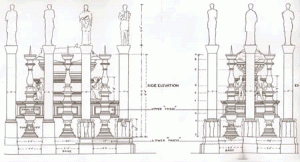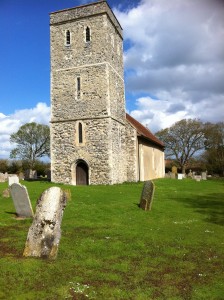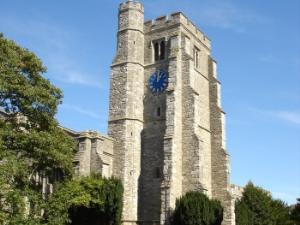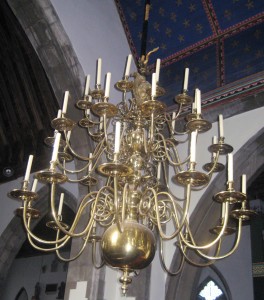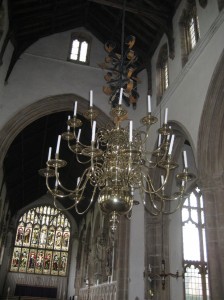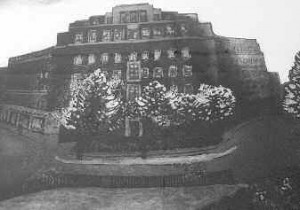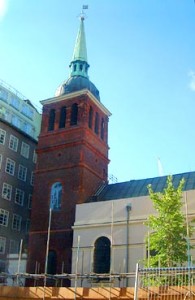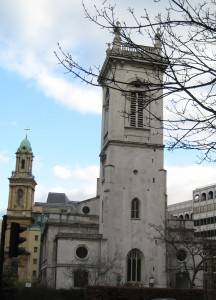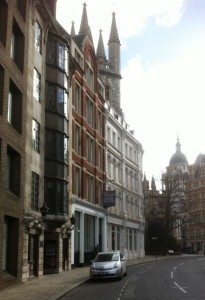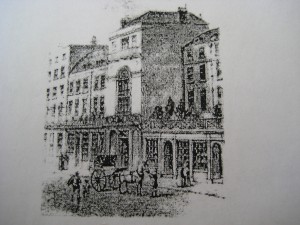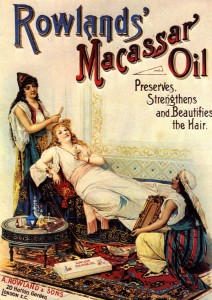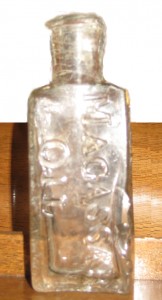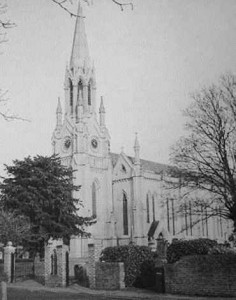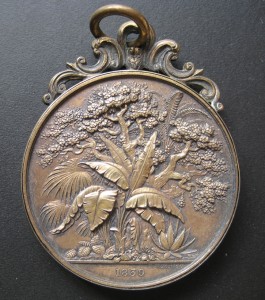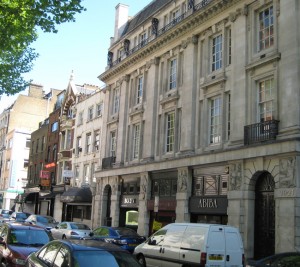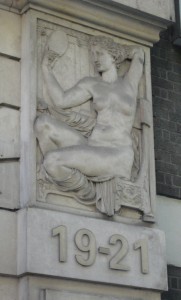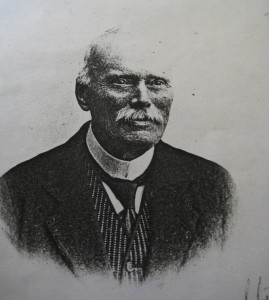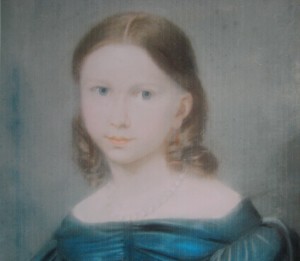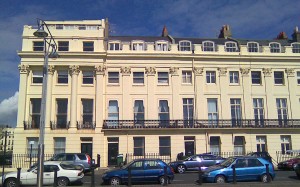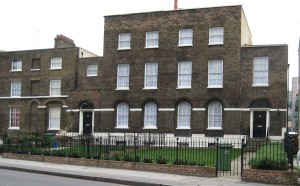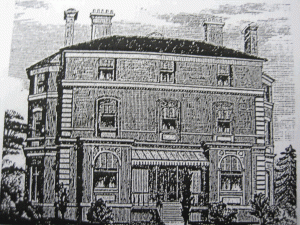Fifteen Generations of Rowlands
Chapter One –1590-1869
Thomas Rowland c 1590 – c 1650
I found my earliest forbear (for the purposes of this book) in the Mormon family search records. The only record of him appears on the baptism record of his son Thomas at St Mary Magdalene, Monkton, Kent on 7th February 1619.
I have also unearthed a Richard Rowlands or Rowlande from the 16th century who is recorded in the National Exchequer Archives as preparing plans and a model of a tomb for Henry VIII at a cost of £13-6s-8d in 1565 and also being paid in 1573/4 for carving figures, presumably for pedestals for the tomb.
There is another, or possibly the same, Richard Rowlands alias Verstegen (c 1550-1640) of Dutch extraction who went to Christ Church, Oxford in 1565 to study Anglo-Saxon. His father was a cooper in East London and his grandfather Theodore Roland Verstegen came to England in about 1500.
He was a polymath, also training as a goldsmith, becoming a Freeman of the Company of Goldsmiths in 1574. He later became a printer and engraver. But he is best known as an antiquarian writer. He had a colourful life; becoming a zealous Roman Catholic, he printed a secret account of the death of Edmund Campion in 1581 and was arrested but escaped to Paris where he was also captured at the insistence of the English Ambassador. In Rome he received a pension from the Pope. In Paris and Rome he published accounts of the suffering of priests in England. In about 1585 he moved to Antwerp and set up business there as a publisher, engraver, an intelligencer and a smuggler of books and people. He died in Antwerp in about 1640. But unfortunately I cannot trace a direct link for these Richard Rowlands to our family!
Thomas Rowland c 1610 – c 1680
As mentioned Thomas Rowland’s baptism is dated 7th February 1619 which would put him at only 11 when he married Elizabeth Cresswell on 12th December 1630 at All Saints, Maidstone; it may be that he was baptised when he was about ten; it is more likely that he was born about 1610.
He was recorded as a freeman in Maidstone in 1631. He had three children, a son Robert and two daughters Deborah and Martha. He had a brother Richard who had a daughter, with children and grandchildren, so the male line stayed with Thomas’ son Robert.
Robert Rowland 1632 – 1707
I came across Robert by the simple expedient of Googling him. He would be amazed. He features in Rulers of London 1660-1689 by Railey-Rynes. He was born near the bridge in Maidstone and was baptised on 10th February 1632 at Lynsted, Kent. His father is named on the baptism record as Thomas. He is also recorded as a freeman in Maidstone in 1691. Like Dick Whittington, he came to the City of London to make his fortune.
Robert married Elizabeth Elliot in March 1661 at St Nicholas Colne Abbey in Victoria Street before it was destroyed in the Great Fire of London in 1666. He was an armourer working in metal, operating between 1689 and 1700 from premises known as the Warming Pan in Gracechurch Street. A number of chandeliers made by him survive, one made in about 1700 was originally in St Peters’ Thetford, and is now at St John the Baptist, Winchester. Another made in 1699 and considered to be the oldest 36 branch chandelier in the country is in St James, Egerton, Kent. It was originally in All Saints, Maidstone, and was possibly donated by Robert. When gas lighting was installed in 1856, the chandelier was sold for £12 to John Holmes who donated it to St James, Egerton. A third is at Walpole St Peter, Norfolk (1702) which has a number of similarities to those now at Winchester and Egerton. There are possibly others at Uffington, Lincs (1685) and Totnes, Devon (1701)
He was elected as Common Councilman for Bishopsgate Within for 1680-3. He owned property in the City, Suffolk, Cambridgeshire and Kent. He was described as “rather good” and “ a good churchman”. He certainly tried to get into the good books of the Lord by complicated arrangements in his will to leave £120 (about £10,000 now) to be loaned to young tradesmen in Maidstone, at 3.33% interest amounting to £4 p.a.. This was to be used to pay the Minister of All Saints £1 to give a sermon on the evening of 1st February each year, with 2/6 to the reader of the lesson, 2/6 to the officiating clerk, 3/- for candles and £2 to the poor living in the West Borough on the bridge and under the cliffs in Maidstone, yearly for ever! The balance went to the churchwardens “for their pain and trouble”. He also left the Armourers Company a legacy of £3 if the Master, Warden and Assistants came to his funeral!
He appears on the list of benefactors of All Saints; he is still mentioned in the Candlemass service commemorating benefactors. He gave legacies to his sisters Deborah Cooke and Martha Everden and an annuity to his daughter Elizabeth Dunwell, with the residue going to his son Robert.
He had four children, John and Susanna who died young, Elizabeth who married Michael Dunwell and Robert. He was buried at St Peter, Cornhill on 24th June 1707.
Robert Rowland 1665-c 1735
Robert was christened at St Peter, Cornhill on 14th May 1665. Possibly he rather jumped the gun with the birth of his son William in 1681-he is recorded as marrying Elizabeth Chapman two years later on 13th October 1683 at St Benet, Pauls Wharf. It is likely that he continued in his father’s business.
William Rowland 1681- c 1750
I came across William surfing through the Mormon online parish records.
His baptism is recorded on 18th December 1681 at St Peter, Cornhill, just down the road from my offices in Cheapside; his parents are stated as Robert and Elizabeth Rowland.
William Rowland 1710- c 1770
The baptism of this William appears in the register of St Andrew’s, Holborn on 4th April 1710; his parents are stated as William and Elizabeth Rowland.
I have little to go on; he was a member of the Cordwainer’s Company, so would have been engaged in leatherwork, making boots, shoes and saddlery. The house which we acquired in 1980 in the Forest of Dean was built in the late 17th century by a successful tanner, so perhaps he was a supplier of cured hides to William. As stated above he was christened in Holborn in 1710 and was living there with his wife Elizabeth née Jones at the time of the birth of his second son Alexander.
Alexander Rowland I 1747-1823
Alexander I was baptised at St Andrew’s, the second son of William in 1747. He was apprenticed on 4th August 1763 to Mary Withybed, barber, of George Yard, Snow Hill for 7 years. He joined the Barber’s Company as a Freeman when his apprenticeship ended on 7 August 1770. He then operated as a barber from Grays Inn Lane. The mythical barber, Sweeney Todd, would have been carrying on his grisly trade nearby in Covent Garden.
Alexander I then moved his premises to next to the Thatched House Tavern in St James’ Street, and became a celebrated hairdresser; he charged the then exorbitant sum of 5 shillings per haircut (about £13 now) In contrast, at this time Richard Arkwright was trying to attract customers in the Midlands at 2d per haircut. Alexander’s clientele would have been the denizens of London’s club-land namely the litterati and glitterati of London Society. The Thatched House Tavern itself hosted dinners for the Dillettanti Society in a room lined with portraits of its members by Sir Joshua Reynolds (1723- 1792) This Society was a meeting place for litterateurs for two centuries. The Thatched House Tavern stood on the site of the Conservative Club built in 1843 and it was replaced by the Civil Service Club in 1865; the original building was demolished in 1814. According to John Timbs “Beneath its front was a range of low built shops including that of Rowland, the fashionable coiffeur of “ Macassar” fame”.
He married Mary in the late 1770’s, and they had two sons and two daughters. Of these I only have details of two; Sarah was born in 1779 and married James Weston, a cement manufacturer; and Alexander II was born in 1783. I have a record of Alexander visiting his brother in Maidstone in 1824.
I will let the Dictionary of National Biography take up the story; “It was then not uncommon for a well connected barber to start making his own hair preparations, and about 1783 Alexander I offered for sale Rowland’s Macassar Oil, an “elegant, fragrant and pellucid oil” of vegetable composition. His son (Alexander II) later stated that a relative living in the island of Celebes in the Dutch East Indies had helped by procuring the basic ingredient, which was extracted from the seeds of various species of trees (probably the ylang-ylang flower) near Macassar. The unguent was basically palm oil with some additions, but may never have been anywhere near Macassar.
Within two decades the oil had become hugely popular. In the first canto of Don Juan (1812) George Gordon, Sixth Baron Byron, worked in a topical gag, (stating when denigrating his wife – “In Virtues nothing earthly could surpass her, save thine “incomparable oil” Macassar!’). Two years later the Tsar of Russia was reputed to have asked for 10 guineas’ worth to be sent without delay via the Foreign Office”.
This probably started the claim that the hair oil had anointed all the crowned heads of Europe! Even more remarkably the Zulu Chief Shaka traded his kingdom to early British pioneers in return for a supply of Rowland’s Macassar Oil. A bottle of this had appeared in a visitor’s medicine chest; since it had restored his hair colour, Shaka thought that it possessed rejuvenatory powers; he was never able to test this since he was murdered shortly afterwards in 1828.
Macassar Oil is also mentioned in the zany wanderings of the White Knight in Lewis Carroll’s “Through the Looking Glass”.
Alexander I also diversified, for example with the skin preparation Kalydor, made with oriental “exotics’, Odonto, a white, fragrant tooth powder, and Alsana extract to relieve toothache, flatulence, and spasms.
Rowland’s Macassar Oil is credited as being, together with Warren’s Shoe Blacking, one of the first nationally advertised products. It was certainly promoted in extravagant terms as in the Edinburgh Examiner of June 1812- “Mrs Raeburn, North Bridge, has just received a fresh supply of that beautiful production, Macassar Oil, for the hair, a preparation that surpasses all others for eradicating all impurities of the Hair, and increasing its growth where it has been bald for years; strengthening the curl, and imparting a beautiful gloss and scent; in fine, rendering the hair of ladies, gentlemen, and children inexpressibly attracting. View Rowland’s Essay on the Hair. This inestimable Oil has also received the august patronage of their Royal Highnesses the Prince of Wales and Duke of Suffolk, and a great number of the nobility”.
Part of the success of Macassar Oil resulted from its avoiding the imposition of a tax on hair powder, presumably to finance the Napoleonic wars. A small bottle cost three shillings and six pence (about £10 now)
Alexander I was also a prudent business man-he appears in the National Archives insurance records as insuring his business on 29th May 1816, recorded as Alexander Rowland, 1 Kirby Street, preparer of Macassar Oil.
In 1820 he married Sarah Slade, a widow with no children. He died at home in Lewisham in 1823 at the age of 76. His estate was valued at £6,000 (about £500,000 now) By then his son Alexander II was 40 and would have been running the family business.
Alexander Rowland II
1783-1861
Alexander II was baptised on 18th June 1783 at St Andrew’s Holborn, and joined the family firm at a young age. He married Elizabeth (1778-1850) in 1807 and had five children.
On Ist March 1808 the Barber’s Company Court Minute states “Alexander Rowland of Kirby Street, Hatton Garden, London, Barber, was admitted to the Freedom of this Company by virtue of his Father’s Copy and on the testimony of Jacob Bonwick, Citizen and Barber and was sworn”.
Thus unlike Alexander I who served seven year’s apprenticeship, albeit without payment, he joined through patrimony, namely being introduced by his father.
The Dictionary of National Biography states “In 1809 Alexander II published an Essay on the Cultivation and Improvement of the Hair, its puffing intention being made clear from the sub-title about the virtues of the Macassar Oil. He followed this with a number of works on similar themes.”.
His essay contains the quotation “Faith, his hair is of a good colour-an excellent colour”, from As You Like It, Act III. It describes the Island of Macassar and the luxuriant hair of the natives who extract the oil from the local vegetable trees “ and continue the use of this oil from infancy to mature old age…….The proprietors ( A. Rowland and Son ) with the assistance of a relation in the island and by permission of the Governor got possession of a great quantity of these ingredients, prepared the oil and found it to have such extraordinary virtues, that it excited general astonishment. Nothing but a full conviction of its incomparable excellence, would have induced them to have submitted the Macassar Oil to the public…..”
“In 1816 Alexander II was admitted to the Livery of the Barber’s Company. More publicity conscious that his father, he recognized that in the age of the dandy, his firm had to strive to bring perfection to gentleman’s faces and hair. However, for all its pellucidity, the oil stained the backs of padded chairs, thus leading to the widespread introduction of antimacassars to protect the upholstery ”. Out of solidarity with my Macassar Oil forbears, I have included an exhortation “ Death to all Anti-Macassars” on our notepaper! Alexander II was quite a showman, and appeared in church with half his moustache dyed black to promote his hair colourants.
“By the 1840s he was widely claiming that the oil was being used by the Royal Family and nobility of England, as well as by several sovereigns and courts in Europe. The Queen’s patronage was boldly proclaimed on the double-fronted Macassar Oil and Kalydor Warehouse at 20 Hatton Garden. In contrast with his father, Alexander II actively participated in the affairs of the Barber’s Company, joining the Court of Assessors in 1845 and becoming Master in 1851”.
I have two letters written by Alexander II to his wife Betsey from June and July 1824, when he was travelling to Maidstone, possibly to visit his brother. One letter is addressed to “ Mrs Rowland, Lee” and states “Accept my love and that of my brother to you, and Sophia (his daughter) and Alex & John (his sons).” In September the following year John, then aged about 15 wrote to his parents from Brighton where he was staying with Alex and “Aunt” (maybe his father’s sister Sarah, or a sister of his mother) Anyway she had a short illness. The letter finished in typical florid style “I remain, my dear and honoured parents, your dutiful and affectionate son, John Henry Rowland”.
In August 1826 Alex writes to his mother from Margate stating “ Tell John to keep my pistols loaded”.
In September 1828 Alexander II took an autumnal tour with his two sons to Cheltenham. They passed through Witney visiting Uncle Collier (possibly Betsey’s brother) They decided Blenheim was not so beautiful a place as Stow Park.
In the 1851 Census he is described as a 66 year old perfumier, employer of 7, living at Rosenthal, Bushey Green, Lewisham, with Sarah Weston, his widowed sister, his three unmarried daughters and four servants.
Alison Creedon’s biography of Dame Henrietta Barnett, Alexander II’s granddaughter describes the development of Lewisham in the 19th century as follows-
“By the end of the 18th century, Lewisham had become a desirable retreat for affluent urban dwellers, As Lewisham’s agricultural industry declined, farm houses were eagerly snapped up and modernised by entrepreneurs weary of the clamour of central London. Meanwhile, villas appeared on formed arable land alongside the shops and small businesses starting to flourish on Lewisham’s High Street. So, by the mid-19th century, Lewisham had made the transition from village to town, but it retained much of its pastoral charm. The work of Henry Wood, the earliest known photographer of Lewisham, reveals an idyllic landscape; sun-speckled woodland, sparkling rivers, creeper-covered houses and ancient thatched cottages. And the names of the two Taverns – The Two Brewers and the Plough and Harrow bear witness to Lewisham’s former industries, even if they did refresh the spirits of careworn business-men, rather than those of agricultural workers. Meanwhile the feudal grandeur of Lewisham was preserved by the renovation of its 18th century mansions. As an 1838 writer enthused: “A little to the south of the church…. a fine panoramic view presents itself. On the north, the church tower, through a break in the luxuriant wood, forms the chief feature of the beautiful landscape. To the westward is seen the Priory, the elegant castellated seat of John Thackeray Esq., with its gothic windows of stained glass, and rich surrounding scenery…Further southward is the mansion of Henry Stainton Esq., and beyond it is Rosenthal, the residence of Alexander Rowland Esq.”
Rosenthal House was set back from the main road and surrounded by acres of woodland and landscaped gardens overlooking open fields and farmland. As well as the main house, there were numerous outbuildings, including stables, coach houses and greenhouses. On one of the lawns was a magnificent fountain, around which peacocks would strut”. It was demolished in the 1890s.
Alexander II was a keen gardener, winning prizes for his roses. He also delighted in showing his grandchildren how to grow flowers, fruit and vegetables. In the autumn of his life, his son Alexander William lived nearby and his grandchildren would come to visit him; his grand-daughter Henrietta’s diary records how she and her brother Fritz would torment him, by tickling his nose with a straw whilst he slept; he jumped up with a start whilst the children hid, convulsed with laughter behind his big leather chair.
In his Will dated 9th May1860 he directed that his funeral be very plain and gave his sons Alexander William and John Henry, £50 and £40 respectively for “mourning”. He left £100 to his nurse Sarah Micheson and a life interest in £400 Consols to his widowed sister, Sarah Weston. His daughter Sophia received four leasehold houses in Exchequer Place, Lewisham, and one other cottage and two acres of rose garden nearby. His other daughters were not mentioned- Rebecca died in 1855; I have not traced Elizabeth’s death records.
The Will records that Alexander II, his sons Alexander William and John Henry had been co-partners in the family business, and that under the terms of the partnership, Alexander II’s interest would pass to them, including “goodwill…stock in trade…steam engine, plant, implements, utensils….some of which are at Hatton garden…and others…at Rosenthal”
The residue of the estate went as to Alexander William, subject to a life interest in half to Sophia. In fact she outlived Alexander William by a number of years.
Alexander II died on 13th July1861 at Rosenthal; his estate was valued at £8,000. But a settlement document dated 1st November 1862 records payments of £11,250 to Alexander William, £10,000 to John Henry and £5,000 to Sophia; maybe these payments represented interests in the business.
It is noticeable that other than sharing in the business, John Henry, as a second son did not share in the residue. He was living nearby in Croydon with his family of five children and four servants at the time.
Strangely my great grand-father, the Rev William John, never mentioned John Henry’s side of the family; his son-in-law Sir Philip Gibbs, who married his daughter Agnes, and who went on continental tours with him, did not hear of them until Dudley Layton, husband of Stella Rowland wrote to him, having read about Sir Philip’s link to the Rowland Macassar Oil business in one of his autobiographies. Dudley claimed that Stella’s side of the family had the business. Originally Sir Philip thought he was an imposter, but of course all was revealed, and my parents became good friends with Dudley and Stella, and I with my fourth cousins. Perhaps it all stemmed from the Rev. William John having nothing to do with his relations!
Alexander William Rowland 1808/9 to 1869
Alexander William was the eldest surviving son of the second generation of Macassar Rowlands; his elder brother Alexander died at the age of nine. His brother John Henry was two years younger, and he had three younger sisters who did not marry.
It is likely that his early life was in Lewisham; a letter from him from the continent where he was travelling with his Aunt and sister Sophy to his mother in 1834 is addressed to her in a cottage in Lewisham. By 1838 they would have moved to Alexander II’s mansion, Rosenthal. In any event he would have been brought up in a very well to do environment.
He travelled to Carlsruhe in Baden in July 1830 stating in a letter to his mother “I would forfeit half my life if you and your father could be here (during the fine weather) because there is sufficient to see to make you prefer Lewisham to any spot in the world, but believe me it is true-these Germans are filthy creatures and the country corresponds”. I imagine he was playing to his mother’s and her father’s prejudices; anyway his views tempered and he married a German, Henriette Ditges about ten years later.
At the age of about 26 he was doing his “Grand Tour” of Europe; I have a copy of the journal he wrote about this. It was hardly a dollar a day backpacking trip. He describes himself as “lionising” the places he visited, probably a discreet word for living it up. Certainly he did not stint on hotels, the Danielli in Venice, and regular visits to the opera. He became quite a connoisseur of the Barber of Seville, having seen it so many times! My overall impression of him from the journal is of a well read and articulate and confident young man, with an enthusiastic interest in the arts, particularly the visual arts; he tramped through all the best galleries in Europe. In a letter to his mother in September 1835 from Venice, he describes it as “the most singular, grand, filthy, miserable, decayed, stinking, beautiful city extant”.
Even by the age of 26, he had travelled on the Rhine nine times. He also mentions four months travel in 1833, including a visit to St Petersburg. In July 1834 he wrote to his mother from Coblenz stating “ Last night I supped with Mr Ditges who had prepared a grand supper- there was present …..his daughter, a nice little girl of about 12 years of age who is going to London next year”. In fact she was about 15, and he married her about 5 years later.
His journal entry for 25th August 1835 when in Baden reads-
“Rained in torrents. Wrote letters. The fashionable hour for dinner in Germany is one o’clock, which occupies two hours, supper nine o’clock, again two hours: the other part of the day is employed in smoking.
Tom Moore somewhere says “Oh that our life like the Germans might be Du lit a la table-de la table au lit”
The cooking is a bad imitation of the French, at dinner they play with your appetite by giving you messes until you lose it, and then provoke you by putting a good joint on the table, everything is either very rare or very greasy and the wine is exceedingly bad.”
However he seemed to have begun to like the Germans, commenting on their congeniality and “their free and liberal manners in comparison with our dull countrymen, for I think a German might travel in an English stage coach for ever, and never be invited by an Englishman”
His views of Italians were less favourable-
“The women in this part of Italy (Venice) do not possess any personal beauty, they are generally ugly with skin resembling the outside part of roast pork- bad figures and much worse dressers; and like the men flee everybody which approaches near them.”
By comparison-
“The idea I have formed of Germans during the twelve months I have spent among them, is that the women are accomplished, industrious and virtuous and make good housewives; in large cities and in the country towns they are generally pretty but not fine featured, neither are they fair, but have clear jaune complexions with an agreeable mixture of the rose. In figure they are not as perfect as the French, but they are finer and much larger women.
The men are not as handsome as the Italians, have more expression in their countenances than the English, but as their features are more varied so some are extremely ugly as well as others the contrary; they are bad dressers and cannot by any means be called a polite people, they are generous, free and good natured”.
In October 1839 Alex and his parents visited the Ditges family at their schloss in Honnef am Rhine. Alex writes to Jack (his brother John) stating “Yetta looks very pale, but pretty and interesting” There is also a note in the same letter from Henriette to Alex’s sister Elizabeth, stating how she was “ agreeably surprised to see your dear father and mother in Honnef”. Perhaps they were just checking out the Ditges’s and their real estate. It must have been satisfactory since Alex married her the following year when he was thirty and she was twenty.
Thereafter followed a dozen years of constant procreation culminating in a classic Victorian family of eight children in all the traditional occupations, except the army, as follows-
Thereafter followed a dozen years of constant procreation culminating in a classic Victorian family of eight children in all the traditional occupations, except the army, as follows-
Alexander-died young
Henry Edward – in the family Macassar Oil business Footnote 1
William John – Vicar in the Church of England
Theresa (Tessie) – married to Barham Snelling, editor of the Egyptian Gazette (Alexander William used to spent the winter months in Alexandria so perhaps this was the link)
Frances (Fanny) – the barmy one, injured during her mother’s pregnancy by a “carriage accident”. She had a mental age of seven, and was looked after all her life by her younger sister Henrietta
Alice – a doctor, when women could only practice after 1865. She married Dr Ernest Hart, a heart surgeon and editor of the British Medical Journal. She also ran silk mills in Dublin.
Frederick Alexander Arthur (Fritz)-solicitor (Tree 5) Footnote 2
Henrietta – celebrated social reformer, working in the east end of London. She married Canon Barnett, and latterly founded Hampstead Garden Suburb.
The 1851 Census records the family then living at 96 Queens Road, Clapham with Tessie, Fanny, Alice and Fritz, and five servants; Henry Edward and William John were then at the family’s holiday home at 18 Brunswick Terrace, Brighton. In the 1840s Alexander William had also leased the Grange, Honor Park Road, Sydenham. It was the largest mansion in the road with 12 bedrooms and grounds of 15 acres. Like Rosenthal, there were lawns, gravelled paths, shrubberies, herbaceous borders, rockeries and ornamental water features.
Henriette died following the birth of her eighth child (Henrietta) in 1851. Alexander William brought in his sister Aunt Sophia to look after the young family, together with nurse Mary Moore. He did not remarry. However, he took a mistress, Caroline Sadler, widow of James George Sadler, a mariner who died in 1851. With her, Alexander William fathered four children. Footnote 3
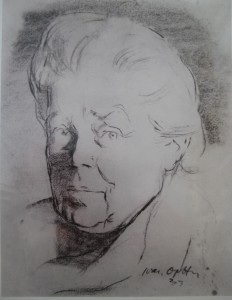
Drawing of Dame Drawing of Dame Henrietta Barnett by Ivan Opffer © National Portrait Gallery, London
Drawing of Dame Drawing of Dame Henrietta Barnett by Ivan Opffer © National Portrait Gallery, London
Much has been written about the life of Dame Henrietta Barnett, including her early life, based on her diaries and journals of her companion, Marion Paterson. One expression from Henrietta’s diary stated that her father “and his worldly art loving friends took their pleasures with a careless generosity”. Certainly he does not appear as a strict Victorian pater familias; Sunday evenings in the Rowland household were not spent reading the Bible or other improving tracts. Rather, Alexander William would gather his children around him and foster their appreciation of art by looking at paintings and encouraging them to engage with their diversity of style, theme and techniques.
In the winter, the family moved from London to escape the fog and smog, to Brighton, to a tall white-stuccoed house overlooking the sea. Although Brighton had the healthy sea air, it also had a raffish reputation, and this may have attracted Alexander William and his worldly pleasure-seeking friends. As mentioned he also travelled to Alexandria to winter there. He thought it was “unwholesome” to be in England if one had a weak chest, and on one occasion ordered his daughter Henrietta to join him there.
In 1860 increasing prosperity allowed Alexander William to move his family from the Grange to the even more opulent surroundings of Champion Hall, Sydenham Road. This was a newly built mansion in a speculative development. It later became the Sydenham Children’s Hospital and was demolished in 1991.
After the death of Alexander II in 1861, Alexander William carried on the business in partnership with his brother, John Henry who was living nearby at 55 Beaulah Wood, Belmont, Croydon with his wife, five children and four servants.
The insurance premium was £26-12s-5d per quarter (now £6,500 p.a.) Life insurance cover of £8,150 (now £500,000) Dog licence-10 shillings Parish rate at St Andrew’s Holborn £14-12s-5d (maybe for office premises at 20 Hatton Garden and Bride Court) Payments to his son Rev. William John of £130 plus a loan of £100 Rev. William John takes his first service in September 1868. Also on 7th September, 1868 expenditure of £50 (now £3000) on his daughter Tessie’s wedding breakfast. (My daughter Tessa’s wedding was in June 2010; her wedding reception cost a bit more!) Purchase of 20 copper cans of 25 litres of rose water (two years old) at 1 franc-40 centimes per kilo (maybe to perfume Rowland’s Macassar Oil) His weight recorded on 16th August 1867 as 11 stones 7 lbs There is a payment of income tax of £3-11s-4d, but it is not clear what, or which period this relates to.
In 1866 they took their sons, respectively, and confusingly, Henry Edward and John Alexander as partners in the family business. The Articles of Agreement of 5th June 1866 was a pretty one-sided document. Alexander William and John Henry only had to attend to the business “at their convenience”, whilst their sons had to attend from 10 a.m. to 4 p.m. each day, except Sundays, with 30 days holiday her annum, unless prevented by illness or a “good excuse”. Liquidated damages of two Guineas (£25 now) were payable for each day of non-attendance in breach of this covenant! So even the proprietors had their noses to the grindstone in those days.
I have Alexander William’s cashbook for 1868, the year before he died. It probably records transactions from one bank account. He liked to maintain a balance in cash of between £500 and £1,000 (now £30,000- £60,000), and his annual expenditure was about £3,000 (now £180,000)
Here are some miscellaneous items from the cash book. The fire insurance cover for his properties totalled about £1 million in current value.
| 4 cottages in the Grove, Lewisham, £400 | 4 houses at Bole Green |
| I house in Barbican, £600 | Rosenthal |
| 10 houses in Greenwich, £1,500 | 1 house in Lee Road, £800 |
| I house in Southfield, £1,000 | 2 houses at George Place, £300 |
| 19 Brunswick Terrace, Brighton, £1,130 | Champion Hall, (Building £3,500-Furniture £3,000) |
| Bride Court £3,000 | The rent of Champion Hall was £146-5 shillings per quarter (now £30,000 p.a) |
The insurance premium was £26-12s-5d per quarter (now £6,500 p.a.) Life insurance cover of £8,150 (now £500,000) Dog licence-10 shillings Parish rate at St Andrew’s Holborn £14-12s-5d (maybe for office premises at 20 Hatton Garden and Bride Court) Payments to his son Rev. William John of £130 plus a loan of £100 Rev. William John takes his first service in September 1868. Also on 7th September, 1868 expenditure of £50 (now £3000) on his daughter Tessie’s wedding breakfast. (My daughter Tessa’s wedding was in June 2010; her wedding reception cost a bit more!)
Purchase of 20 copper cans of 25 litres of rose water (two years old) at 1 franc-40 centimes per kilo (maybe to perfume Rowland’s Macassar Oil) His weight recorded on 16th August 1867 as 11 stones 7 lbs There is a payment of income tax of £3-11s-4d, but it is not clear what, or which period this relates to.
Alexander William’s Will was quite a comprehensive document. There are legacies and annuities to Aunt Sarah Weston (who was then about 90) and his sister Sophia, and legacies and residue to all the children except Henry Edward, the eldest son who was well provided for through his share of the business. The Will attempts to provide that daughters marrying retained control of their inheritance, although this was not legally possible then. It certainly shows an enlightened approach to his daughters. The Will refers to a buy-out mechanism in the Partnership documents for Alexander William’s share, payable to his estate over 5 years. The value of the estate was originally sworn at £35,000 on his death in 1869, but was re-sworn in 1873 at £45,000, possibly to include the buy-out payment or maybe Aunt Sophia’s life interest in half Alexander II’s residue fell in. The estate would have a current value of about £3 million, so each of the children would have received the equivalent of £500,000 now. It is likely that this did not include the market value of the business. At the time £10,000 per annum was being spent on advertising. If that was 10 per cent. of turnover, the business could have had a value of the equivalent of £10-20 million now.
Alexander William died on 28th June 1869 at Champion Hall. After his death the family moved to a smaller house in Westbourne Terrace, Paddington.
In 1870 Rev. William John had already commenced a claim in the Chancery Court against his sisters, in relation to the Will, relating to purchases of furniture from the estate; but this was settled quite quickly.
Chapter 1 Footnote 1
Henry Edward Rowland’s family
Jacky Fogerty has been filling out the tree with information about Henry Edward Rowland brother of Rev William John Rowland, and an expert on the Doomsday Book, and his descendants. She writes-
I have had a look at Henry Edward Rowland’s family as you suggested.
- Descendants of Henry Edward Rowland (1843-1882) and Victoria Jane nee Walker (1843-1889)
Henry and Victoria are very well documented, with lots of records including probate etc and a good Census trail. There were two Henry E Rowlands born around Lewisham at this time and there used to be a tree on Ancestry which had this family and their descendants attached to a different set of parents and poor Henry Edward spending his youth as a boot boy. I emailed the owner and politely mentioned the baptism records with correct parent names, the records showing the name of Henry’s father on his indenture papers, marriage record with fathers’ names etc but they did not reply and I don’t know if they changed their tree. I think from memory it did not look as if the tree owner was descended from our branch of the Rowlands.
Four of Henry and Victoria’s five children, including their two sons Alexander Henry (1868-1924) and Walter Otto (1875-1903), appear to have died single and without descendants: I have extensively searched Marriage Index and parish marriages on Ancestry and Findmypast as well as Censuses and have searched hard for others with the same name or initials, but none fits the bill.
Alexander Henry was an accountant, single in 1891, 1901 and 1911 Censuses, living with his sister Victoria Edith Bassett nee Rowland in 1891, with non-relatives in 1901 and with his aunt on his father’s side in 1911. This may have been because he was frail or just for ease of housekeeping. He died in 1924, probate to sister Victoria Edith Bassett nee Rowland. I cannot find any military service records.
Walter Otto Rowland (full name from Birth Index and Baptism record, the latter lists both parents) seems to have been living in an odd arrangement in 1891 (soon after his mother died), in a large single house with a non-related head “living on own means”, several servants and one other person who was a “lunatic”. This seems to have been some sort of private care arrangement. The age is wrong (he was 16 not 13) but the name Walter O Rowland and place of birth are correct. In 1903 Walter Otto Rowland died at Colchester (Death Index) and Walter Otto Rowland was buried at St Paul Colchester on 21 Feb 1903 (Parish Records Collection 1538-2005, findmypast.co.uk). I cannot find any other possible deaths or burials. In the 1901 Census, “W O R” was a patient at Eastern Counties Asylum for Idiots Imbeciles and the Feebleminded, Colchester, Essex, England, labelled “imbecile”, correct age and place of birth (at this time, people in asylums were often recorded by their initials in the Census).
Florence Ethel Rowland (1874-1898, you have her on your tree as Flossie), also died young, at sea, in 1898, and seems to have been living at least part of the time with aunt Henrietta Barnett nee Rowland – “Florence Ethel Rowland of Toynbee Hall, Whitechapel and 8 Royal York Crescent Clifton (Bristol), spinster, died at sea”, probate to Francis Gilmore Barnett, brother of Canon Samuel Barnett.
Alice Maud Rowland (1870-1957-8?) was definitely a spinster at 41 in the 1911 Census so I think we can rule out children. In 1881 she is called Maud Alice Rowland, student, same school as her sister Victoria Edith Rowland, see below, right age and place of birth. I have not found her in the 1891 Census but in 1901 she is visiting her aunt Alice Marion Hart and calls herself Maud Rowland, single, 30, born Sydenham, occupation “designer – linens, author, artist … own account, single”. By 1911 she has settled on Alice Maud and refined her occupation to “artist, single” and is living with non-relatives “age 40″. In 1929 Alice Maud Rowland is living in Wandsworth. There are two Alice M Rowlands in the phone directory until around 1955, one in Clapham and one in Lewisham. The only two Alice M Rowland deaths that look possible for her are in Surrey mid Eastern in 1957 and Hove Sussex in 1958, and I cannot find any probate or burial records.
The oldest child, Victoria Edith Rowland (1867-1944, you have her as Edith) married John Dollin Bassett (1864-1949), stock jobber, employer, in 1889 and they had six children. In 1891 they had a son John Albert (1890-1892) and her brother Alexander Henry living with them. After John Albert’s death they had Geoffrey Edward Bassett (1894-1918), Marjorie Edith Bassett (1895-?), Douglas Dollin Bassett (1896-1969), Sybil Helen Maud Bassett (1903-1988) and John Dollin Bassett the younger, (1909-?). In the 1901 Census, John and Victoria are staying with his cousin, without the children, but birth records are all in order and some baptisms, and in 1911 Census the family are all together.
John Albert and Geoffrey Edward died young, no marriage records for Geoffrey, Lieutenant, Army Supply Corps. He was killed in action and is buried in Picardie, France, two medals, service details and nice photo of cemetery on international find a grave index (eg also see Ancestry or forces-war-records.co.uk). John Dollin Bassett senior also served in WW1 in the Army Pay Corps as a temporary captain, two medals also.
Douglas Dollin Bassett (1896-1969) also served in WW1, also has medals, subsequently described as a Company Director (coal merchants) in probate for both parents and wife Catherine M nee Spiers (1897-1964). I cannot find any children by my usual method of checking for other family trees and, if this is not successful, putting in “unknown Bassett”s with birthdates in right range until all the children with that surname and mother’s maiden name (in this case, Spiers) on their birth index record show up in searches.
John Dollin Bassett (1909-?) was an insurance broker in 1944 when his mother’s probate went to him and Douglas. Have not found any definite records after that so far but will keep trying. Wife Doreen B Airs (1919-?) is also elusive. No children found by the methods outlined above. As Bassett is quite a common name, the best hope with both of these might be that one of their descendants puts a tree up on Ancestry.
On the other hand, both daughters definitely had children.
Marjorie Edith Bassett (1895-?) married Archibald N Palan (1898- ) who was born in Buenos Aires to an English mother who also lived in the United States for some time, as did Archibald (including after his marriage). They had one child in England, Geoffrey B Palan (1921-?), who married the wonderfully named Lulu St Claire Gower Williams (1921-?) in England. It is possible that Marjorie and Archibald had more children in the US but none of those showing up look particularly likely.
Geoffrey may have changed the name spelling to Palin as there are two baby girls Jacqueline H Palin (1947-1948) and Patricia J Palin (1949 – ), mother’s maiden name Williams, born in the right area at the right time. A couple of possible marriages for Patricia J Palin, however no death or burial records appearing for Marjorie, Archibald, Geoffrey or Lulu in England and no likely looking ones in United States either. Having said that they may suddenly appear tomorrow, Ancestry sometimes suddenly decides to offer up the record you were looking for for hours the day before.
Sybil Helen Maud Bassett (1903-1988) married Arthur James Mountford (1907-1959) and had two daughters, Helen (1939- ) and Mary (1940-), birth indexes Mountford mother Bassett. Sybil had an obituary in the Times. The daughters show up as private (ie living) on one tree on Ancestry, so it is not possible to see whether they have children and I could not find any marriage records for them (the obituary would probably have family info but it is not readable from Ancestry).
- The solution to the mystery about Ethel Theresa Rowland
As mentioned before, your tree has FAA Rowland’s daughter Ethel Theresa Rowland marrying M J Bassett and having two children Cissie and Dolly. You mentioned that this information was from your father. As you know, my family was told that she died single and in an asylum, so I tested the proposition by creating a new family tree for this family and trying to find them. I could not find any matching records on Ancestry or findmypast- there were no possible Rowland/Bassett marriages or births, and although I found one actual Cissie Bassett and one Dolly Bassett born about the right time (and lots of Dorothys), their parents’ names were wrong.
However, once I got to Henry and Victoria’s eldest daughter Victoria Edith and her husband John Dollin Bassett, all became clear. Your father must have confused her for her cousin Ethel Theresa. She married a Bassett, and their two youngest children, Sybil and John Dollin Bassett, could easily have been Cissie and Dolly as children (especially as their parents had already had a baby John who had died as a toddler – Dolly was a common nickname for boys called Adolphus, so not as cissy then as it sounds now). I still have no explanation for the initials M J – I thought maybe he was a major in the army, but he seems to have been a captain, then I thought maybe it was Mr J Bassett.
Footnote 2
FAA Rowland and the Australian connection
Here is information from my third cousin Jacky Fogerty.
I am a great granddaughter of Percy Fritz Rowland, son of Freferick Arther Alexander Rowland, son of Alexander William Rowland. P F Rowland (as he preferred to be called) emigrated to Australia and has many descendants here. He was the Headmaster of Townsville Grammar, North Queensland, and has an entry in the Australian Dictionary of Biography and a short Biography written by Anne McKay, Percyy Fritz Rowland, University of North Queensland, 1974. He wrote a number of books and won prizes at Oxford.
We have a public tree on Ancestry.com which sets out details of the family (Fogerty/Milfull tree, owner mgjames192) and has copies of a number of birth,,baptism and marriage certificates, as well as BDM index entries, photos, letters and other records.
In relation to your family tree of Federick Arthur Alexanders’s descendants, my grandmother (born Marion Laflin Rowland) corresponded with her aunts in England until they died, kept their photos and was very definite that none of P F Rowland’s siblings had children.
Fredeerick Arthur Alexander Rowland was admitted as a solicitor on Dec 20 1871 and mostly practised from 14 Clement’s Inn. He seems to have fallen out with his family in 1869 when he married a servant girl, Catherine Laflin, daughter of Suffolk farm bailiff Abraham Laflin, at St Clement Dane’s (23 August 1869, bride’s name is given as Kate Laflin). We are very grateful that he did do the decent thing and marry her, as Percy Fritz Rowland, my great-grandfather, was born very soon afterwards.
He did however, at least in the early 1870s, act in some cases for the family, eg in the sale of Rowland assets, and I have some advertisements and legal proceedings attached to my tree on Ancestry.
FAA Rowland and Catherine had three boys and three girls, but the family was very quickly in financial trouble. FAA seems to have inherited his family’s exuberance and wide ranging interests without the finances to support them. He may also have incurred litigation costs as he was personally involved in at least two cases, one relating to alleged fraud by a clerk for the solicitors acting for Alexander William Rowland’s estate, of which I have a transcript, and another as plaintiff in relation to the estate of Anton Leo, for which I have recently put in a request with UK National Archives.
He is first in the London Gazette relating to a liquidation of his assets in relation to bankruptcy proceedings on 19 August 1879, but seems to have avoided bankruptcy on that occasion. There may have been other issues in the intervening period which I have not been able to track down, apart from a couple of partnership dissolutions, but on 12 April 1894 he was declared bankrupt. At that point he permanently disappears from the Law Lists (and from the Census as you say until 1911, when he is a retired solicitor living in Suffolk; in 1901 he is elusive but Catherine is visiting her sister in law Alice Marion Hart). He does not seem to have a probate record, although his wife does, which suggests to me that he never got his affairs onto a sound footing again.
My own theory is that his wife was quietly given money by FAA Rowland’s siblings to support the family. They certainly seem to have traded down into progressively more modest rented country houses in Suffolk as time went on. My great grandfather PF Rowland was able to go to Oxford on scholarship but the other children do not seem to have done this. Stanley, Marion and Henrietta worked as teachers until their retirement and did not marry. Alton emigrated to Canada, married Emma Holland in Quebec and died there childless. I understand he was an accountant and the 1911 Quebec Census bears this out. Ethel Theresa, who was called Cissie, was said to be somewhat feeble-minded and subject to nerves. My understanding is that she did not marry but retired to a rest home/asylum, and in 1911, ET Rowland born Hampton Middlesex in the correct year, is listed at the City of London Asylum and Hill House, as having been a typist.
Frederick Arthur Alexander’s male line has not run out, but I think it is down to one thread. His son Percy Fritz Rowland had one son, Philip Hastings Rowland and three daughters, Marian, Frances and Joan. Philip went off after his Junior Certificate to be a jackeroo (horseman on remote properites) and farmer, later qualifying as an engineer and serving in the air force in Morotai in World War 2. Philip had one son, John Neville Rowland, and one daughter, Helen Beatrice Rowland. John Neville Rowland lives in Tasmania. He has three daughters and grandchildren, but we have been out of touch with that side of the family, so I will just check with his niece that he has not married again and produced sons.
Percy Fritz Rowland’s daughters, on the other hand, had children, almost all of whom have had their own children and grandchildren and some great grandchildren. Frances Rowland’s only grandson is named David Miles Wisely Rowland, as his mother (now deceased) changed her name by deed poll to Marjorie Rowland.
We have always been very proud of the Rowland connection, although my grandmother, who was a bit of a snob, always spoke of them as a landed family with an “estate” in Suffolk and had expectations that she would inherit the (as it turned out non-existent) Rowland money when her aunts died. We had no idea about the association with Rowland’s Macassar Oil or FAA Rowland’s financial troubles or his wife’s humble background until we started researching them. Ironically the research was mostly to track down the elusive “German grandmother” that my grandmother spoke of but had no more information about. We are very grateful that, thanks to your work, we now know so much more about the Rowlands and also the German connection.
I have photos of FAA Rowland’s entry from the Bankruptcy Register from the UK National Archives (BT 293), and the original bankruptcy petitions in 1894 (B 11/11) with more details: the full file references are on my tree. There is also a listing from the London Gazette relating to this bankruptcy and the marriage certificate for FAA Rowland and Kate Laflin. I have not attached the baptism or other records for the children because I copied them so long ago I cannot immediately find them on the system, but they are all in the London Baptisms, Marriages and Burials and images are copied on our tree.
In Suffolk FAA and Catherine Rowland (nee Laflin) lived at Stanstead Hall, Hitcham, and Catherine later lived with Alton, Henrietta and Marion at Mill House, Hartest Mill, Bury St Edmunds. I don’t know whether FAA Rowland was still living when they moved there and I don’t know what other places they lived in, my mother only remembers the Mill House address. I think the family left Mill House for more modest accommodation when Stanley died. Stanley did a couple of ink sketches of Mill House which my parents have framed – I scanned them and copied them on the tree but now cannot find my original scans to send you. I think Mill House may now be a furniture store of some sort, it seemed to be when I last googled it.
I have a photo of Catherine Rowland nee Laflin reading, probably at Stanstead Hall, and one taken by Stanley Rowland of Mill House and Hartest Mill. Also photos of FAA Rowland’s children (l to r: Alton, Henrietta, Percy, Stanley (front, in sailor suit), Ethel Theresa and Marion), PF Rowland with his wife Jessie and the three eldest children (Marion, Frances and Philip), PF Rowland’s entry in the Australian Dictionary of Biography mentioning his parents’ names, and baptism records from the London Register of Baptisms, Marriages and Burials for PF and his brother Alton.
I do not have any hard evidence that Alton died childless, although only he and his wife are listed in the household in the 1911 Quebec Census. However they were in correspondence with my grandmother and she was very definite that Alton had no children and nor did any of PF Rowland’s other siblings, which was why she was expecting the (non-existent) Rowland money when the last sister, Henrietta, died.
In answer to your earlier question about Marjorie Rowland She changed her name to deed poll to Mrs Marjorie Rowland and her son David’s birth was registered as David Miles Wisely Rowland.
My mother was born Alison Ruth Milfull, mother Marian Laflin Rowland, and Marion was the eldest daughter of PF Rowland. As you say, my mother is your third cousin.
By the way, did you know that Rev William John and FAA’s sister Alice Marion Rowland Hart wrote a long, interesting and amply illustrated book called Picturesque Burma about her travels there in 1895? I did not know this until I started looking for Rowland family publications and found a reprint at betterworldbooks.com. They are certainly an interesting family.
Footnote 3
The Sadler Connection
Followers of my tree will remember that Henriette Ditges wife of Alexander William Rowland died in 1851, giving birth to Henrietta. William Alexander did not remarry and he brought in Aunt Sophie to look after the children. However researches by Jacky Fogerty have revealed that he took a mistress, Caroline Sadler, widow of James George Sadler, a mariner who had died in 1844. With her, Alexander William fathered four children –
Alexis-1853
Alexis Caroline-1856
Robert-1858
Ellen Maisie-1861
Alexander William was named on their birth certificates described as a gentleman, but all the children took the surname Sadler. Alexander William died in 1861-the Sadlers were not mentioned in his Will. Mrs Sadler lived in Deptford, not far from Lewisham, so I expect Alexander William would visit in secret in a hansom cab! Interestingly Robert named his father on his marriage certificate as James George Sadler, mariner . Perhaps he just wanted to avoid the implications of illegitimacy-it seems unlikely that his mother would have been able to cover up her liason with Alexander William for 10 years.
Robert Sadler had five children-
William Robert-1883
Bertram John-1884
Victor George-1885
Lily Ethel-1888
Mabel Violet-1871
Victor George spent time in Argentina, returning to Liverpool with his son Martin Gordon born 1931.
At this stage the trail runs cold-Martin Gordon Sadler would be my father’s third cousin.

